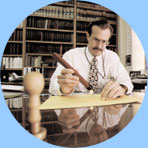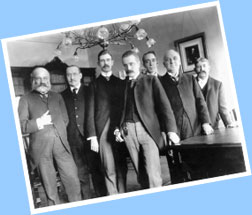|
 he Executive Clerk's
Office is one of the oldest within the White House, serving in support of the
Presidency for more than 140 years. Among the earliest Executive Clerks was
William Henry Crook, a former bodyguard of President Lincoln, who began his
duties in 1865 and went on to serve in the White House for more than 40 years. he Executive Clerk's
Office is one of the oldest within the White House, serving in support of the
Presidency for more than 140 years. Among the earliest Executive Clerks was
William Henry Crook, a former bodyguard of President Lincoln, who began his
duties in 1865 and went on to serve in the White House for more than 40 years.
The Executive Clerk's Office is responsible for the preparation, review, and
final disposition of official documents signed by the President, such as
executive orders, proclamations, messages to Congress, and memoranda to the
various units within the executive branch. The office also receives all formal
documents sent from the Congress to the President, including Senate confirmation
resolutions, resolutions to the ratification of treaties, and enrolled bills
passed by the Congress for the President's action. The Constitution states that
when the Congress delivers a bill to the White House, the President has ten
days to act on the bill. If the President signs the bill, it becomes law. If he
vetoes it, it is the responsibility of the Executive Clerk to deliver the bill
back to the Congress for reconsideration.

Tim Saunders, the Executive Clerk, prepares a wax seal for an important document
from the President to Congress.
|
The current Executive Clerk, Tim Saunders, began working in the Executive
Clerk's Office during President Jimmy Carter's Administration. In 1994, he
became the tenth Executive Clerk in White House history. You may have seen
Mr. Saunders if you have visited the United States Capitol or if you have
watched the Congress in session on television. Whenever the President has a
message or some other important communication for the Congress, Mr. Saunders or
another staff member from the Executive Clerk's Office must deliver the message
in person. Before leaving the White House for Capitol Hill, the Clerk places
the President's message in a special envelope, seals the envelope by heating
red wax onto the flap, and then stamps the wax with a die of the President's
Seal, creating the distinctive impression that identifies the document as a
Presidential message.
When delivering a message to the House of Representatives, the Executive Clerk
participates in one of the oldest continuing traditions within our government.
When the Clerk is introduced on the House floor, the proceedings are
interrupted. The Clerk then formally bows and announces, "Mr. Speaker, I am
directed by the President of the United States to deliver a message in writing."
He then leaves the envelope containing the message and returns to the White
House.

Colonel William Henry Crook (far left), who served as President Lincoln's bodyguard and the first Executive Clerk, poses with staff from the McKinley Administration.
|
Tim Saunders carries on a proud tradition of service at the White House. His
office is filled with mementos and photographs from the Executive Clerks who
came before him, and he enjoys telling young visitors about the history of his
office and the unique role he plays within the White House.

|

